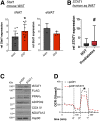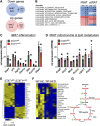STAT1 Dissociates Adipose Tissue Inflammation From Insulin Sensitivity in Obesity
- PMID: 32994273
- PMCID: PMC7679774
- DOI: 10.2337/db20-0384
STAT1 Dissociates Adipose Tissue Inflammation From Insulin Sensitivity in Obesity
Abstract
Obesity fosters low-grade inflammation in white adipose tissue (WAT) that may contribute to the insulin resistance that characterizes type 2 diabetes. However, the causal relationship of these events remains unclear. The established dominance of STAT1 function in the immune response suggests an obligate link between inflammation and the comorbidities of obesity. To this end, we sought to determine how STAT1 activity in white adipocytes affects insulin sensitivity. STAT1 expression in WAT inversely correlated with fasting plasma glucose in both obese mice and humans. Metabolomic and gene expression profiling established STAT1 deletion in adipocytes (STAT1 a-KO ) enhanced mitochondrial function and accelerated tricarboxylic acid cycle flux coupled with reduced fat cell size in subcutaneous WAT depots. STAT1 a-KO reduced WAT inflammation, but insulin resistance persisted in obese mice. Rather, elimination of type I cytokine interferon-γ activity enhanced insulin sensitivity in diet-induced obesity. Our findings reveal a permissive mechanism that bridges WAT inflammation to whole-body insulin sensitivity.
Trial registration: ClinicalTrials.gov NCT02792400.
© 2020 by the American Diabetes Association.
Figures





References
Publication types
MeSH terms
Substances
Associated data
Grants and funding
LinkOut - more resources
Full Text Sources
Medical
Molecular Biology Databases
Research Materials
Miscellaneous

